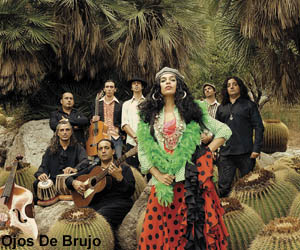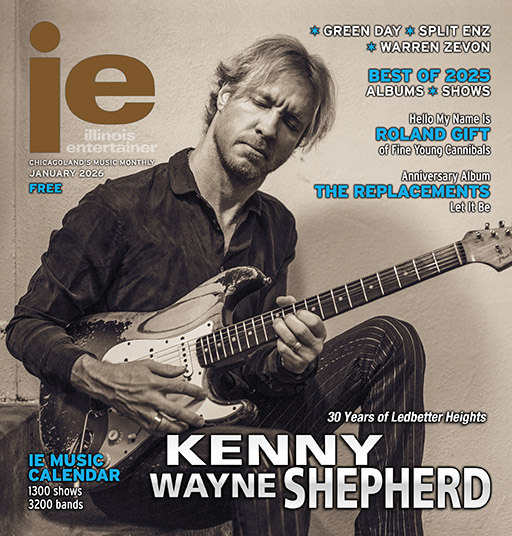Flamenco Fusion
If you think flamenco music means a lace mantilla, castanets, and responsive guitar licks, then Ojos De Brujo (Wizard Eyes) have got something for you. In Spain, flamenco isn’t just music but a culture, and the ramshackle, 10-member ODB collective represent the evolving nature of that culture and serve up a hypnotic fusion that demands the world listen. Forget the Gipsy Kings; if you haven’t heard Ojos De Brujo then you haven’t heard contemporary flamenco.
Flamenco music deeply reflects Spanish culture, from its elaborate vocal ornamentation, to its vivid expression. The roots of flamenco stem from gypsy or Rom immigrants, who arrived in Spain in the 15th century, as well as Jewish and Arabic refugees who holed up in the Andalusia Mountains, away from the Catholic Church’s forced conversions. The music of the three groups fused, creating a singular sound that was preserved through the Rom oral tradition. Although a flamenco artist may be payo or non-gypsy, the most acclaimed performers came from noted Rom cantaora (flamenco singer) areas or families. After flourishing for most of the 20th century, the tradition declined from the late ’50s to ’70s and was regulated to a few clubs and tourist spectacles.

The ’80s resurgence built a significant mainstream presence. Artists such as Ketama, Pata Negra, and El Camaron de la Isla shone the spotlight on the modern possibilities for the folk genre. Ketama was credited with introducing rock and salsa to flamenco, and Pata Negra blended it with blues. The ’90s brought the nuevo flamenco movement that featured artists such as Carmen Linares, Duquende, and El Potitio, who continue to define the genre today. Flamenco music boasts many styles, or palos, including the upbeat fandango, solea, which is considered the foundation for all forms, and tango, which originated in Cuba and is typically presented with the sensual dance. But none of flamenco’s new generation draws from quite as many of these as Ojos De Brujo.
On their third CD, Techarà (Diquela), the group stretch past the revelation of 2002’s groundbreaking BarÃ. Whereas Barà dazzled with an explosion of sounds and textures, Techarà expands on the concept with more detail and depth. Not only does the 14-track album explore flamenco’s mestizo roots to India, Africa, and the Caribbean, it also offers a visual journey in the form of a CD-ROM with four videos featuring art from 14 globe-spanning illustrators.
Each of TecharÑs tracks is a highlight, bursting with traditional flamenco palos as well as contemporary musical influences. The first track, “Color,” kicks off with lead singer #Marina Abad commanding “Mira! Aqui!” And “look here” is exactly what you do as a jumble of horns swirling, percussion pounding, and Abad spitting out rapid-fire Castellano snares your attention. Vestiges of funk and jazz float around the flamenco rhythm for a striking sonic mix. From there the journey continues to flamenco rumba with “Sultanas de Merkaillo,” a smooth track that flows with Arabic undertones. “Todo Tiende” laces furious flamenco guitar licks with Asian Dub Foundation drummer Pritpal “Cyber” Rajput‘s tumbling dhol playing, effortlessly blending bhangra beats with hot rapping. Abad uses her voice like the miraculous tool it is, at times wrapping it around the pulsing rhythms and other times, shooting out raps or exclamations of “ole!”
“Runali” changes it up with soft harmonies spiced with Senegalese hip-hop star Faada Freddy‘s dancehall-tinged rapping, while “Respira” delivers languid, 12-beat, seguirilla-style flamenco with touches of reggae. The guests featured on Techarà make ODB’s expected global music carnival even more colorful. Besides Freddy and Rajput, there’s Indian fusion artist and British TV star Nitin Sawhney, Cuban pianist Roberto Carcasses, and Cuban tres/flamenco guitarist #Raul Rodriguez, from Son de La Fontera.
Aside from their arresting soundscape, ODB are also noted for their sharply socio-political lyrics, written by Abad, who previously worked as a punk rock/flamenco performance artist. Thanks to the 16-language translations on the CD-ROM, non-English speakers can glean the depth of the lyrics. Though immigration remains a touchy issue in Spain, they tackle it head on in “El Confort No Reconforta”: “Human rights die silently day after day/people without papers can’t manage to live their lives legally/immigrants locked in churches, in hunger strikes/does God not exist or have they cut the cable for non-payment?” And on “Piedras vs. Tanques” they send a scathing attack on the war in Iraq: “Going around flaunting your wealth/look! Such offensive joy/dear president, your people do not want to fight anymore/send your own sons to the front if you want to win with wars.” Both tunes appeared on the compilation Bush No Le Va A Gustar (Bush Isn’t Going To Like It), recorded in protest of Bush’s presence at the Summit Of The Americas in Mar del Plata, held in Argentina in 2005.
Ultimately, Ojos De Brujo hope to spread their philosophy of freedom. They have launched their own label, Diquela, as well as their own publishing company. Their artistic freedom also extends to touring; they travel where they please, when they please, with no consideration of economics. Fortunately, the U.S. must offer some pleasure because they will tour here in June and July. Bouncing with eclectic sounds, visions, and perspectives, Ojos De Brujo don’t just represent the future of flamenco, but hopefully the future of the world.
– Rosalind Cumnmings-Yeates












No one in Spain consideres Ojos de Brujo “flamenco”. Ojos de Brujo doesn’t consider Ojos de Brujo “flamenco”.
Inventing this sort of fluff is cultural valdalism. Next time research your topic.
Estela Zatania
http://www.deflamenco.com
It was never implied that ODB is a strictly flamenco band, but a fusion. They acknowledge flamenco as a major influence.